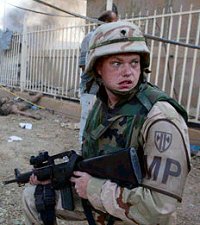Thursday, November 13, 2003

Perhaps some of you noticed, but, I didn’t post anything yesterday.
I tried but my thoughts were simply too ugly for even this almost private publication.
I am going to rest, plan Thanksgiving, load up on firewood and submerge into the world and pottery of late 19th century Cincinnati.
I know, from several conversations and observations over the last few days, that I am not alone in my temporary feelings of dread and helplessness.
A man, in the gym locker room this morning, suddenly began screaming at a hanging television, “Now we are going to get tough? Now? They’ve killed or wounded how many of our boys and now they are going to get tough?
I recognized the voice. No leftie this guy.
This good solid and almost surely Republican Cincinnati burgher was in a loud and very surprising public agony over needless death in a faraway land.
I could hear another fellow ask the man who screamed if he was OK “Yeah,” I could heart him reply, “but it’s all just so rotten. I mean, how did this happen? I’m just thankful I don’t have a son.”
The painter Edvard Munch once described an experience, which caused him to create his most famous work:
I was walking along the road with two friends.
The sun was setting.
I felt a breath of melancholy –
My friends walked on - I stood there, trembling with fear.
And I sensed a great, infinite scream pass through nature.
What Munch described is, no doubt, enhanced by something former Vice President Al Gore said to a Tennessee college class Tuesday as reported by the Nashville Tennessean:
The ''quasi-hypnotic influence'' of television in the United States has fostered a complacent nation that is a danger to democracy…Our democracy is suffering in an age when the dominant medium is not accessible to the average person and does not lend itself most readily to the conveyance of complex ideas about self-governance. Instead, it pushes toward a lowest common denominator.

This photo was taken by New York Times and Polaris reporter and photographer Michael Kamber shortly after the terrorist attack on Red Cross Headquarters in Baghdad. His Digital Journalist dispatch, Normal for Baghdad is highly interesting but difficult reading:
There are two guys helping to direct the rescue -- civilian clothes, English speakers, heavily armed with hi-tech radios and sunglasses, CIA or NSC, heavy hitters. They've got the look and attitude of trained killers. "Get the f--- out of here," one keeps shouting at me, pushing me away. "I'm not interfering, I do my job, you do your job," I respond. "Well f--- off then," he yells, livid as I move away and circle around to keep shooting...More U.S. troops begin to arrive and look terrified, you can almost see them shaking. They recoil from the bodies. I don't think they've seen anything like this before. I begin to focus on the Americans, knowing it's just a few minutes until we're put out of the area. Two MP's stand looking down at a corpse. A moment later another, I see a lone MP drop to one knee near a body laying awkwardly against a fence, the smoke rising in the background. I compose and shoot as the soldier looks back past me, eyes wide with fear - or maybe it's astonishment at what men do to one another.
Remember folks, these soldiers are young American boys. And, as Kamber so brilliantly illustrates, war is never as orderly as the talking heads would want us to imagine.
Detail of painting: Museumsnett Norge
Photo: Michael Kamber-Polaris

